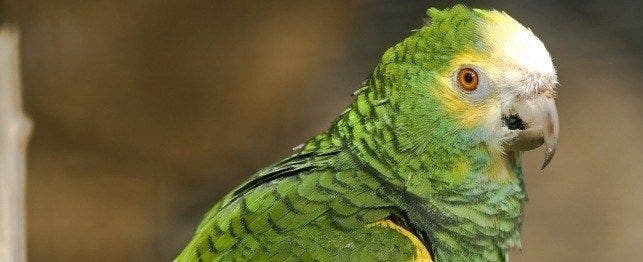
Choosing a Festive Amazon
Festive Amazons are beautiful birds. The body color of these parrots – which range from 11 to 13 inches long – is forest green with slight black scalloping. Their crowns are blue, and the birds have red to maroon markings on the brows and a dark frontal band. Primary and secondary flight feathers are green with blue tips; tail feathers are green with yellowish-green tips complemented by red patches on the outer feathers. Mature festives have a bright red patch on the rump, which is not found in any other species. (In juveniles, the rumps are mostly green.)
In the wild, the birds inhabit lowland tropical rainforests along the Amazon and Orinoco rivers and their tributaries. They live in swampy forests, river islands, cacao plantations, gallery forests and savannahs and are found in pairs and small flocks of up to 50 birds. These hardy parrots can live up to 60 years. In the wild, they feed primarily in trees, but because of their remote habitat, details of the wild diet are not well known.
Subspecies
- A.f. festiva lives in the Amazon River basin; the bird has a horn-colored beak, narrow red frontal band and yellow on the forecrown.
- A.f. bodini lives along the Orinoco river; the beak is black, and the birds have extensive red on the crown.
Festive Amazons are seldom available as pets, and males are more common than females. They are intelligent and inquisitive but tend to be relatively shy, with only poor to moderate speaking ability.
Juveniles are generally tame and can usually be handled. The birds should always be provided with toys, blocks of wood or branches that they can chew. Young Amazons should be socialized to many people and exposed to a variety of situations such as new cages, toys, visits to the veterinarian, handling by friends, wing and nail clips, etc. to avoid fear of novel situations. Since they are active by nature, festives need to have space to exercise.
Feeding
Festives are not as prone to obesity as are other Amazons. They should be fed a formulated (pelleted or extruded) diet supplemented with fresh fruits and vegetables daily to add variety and psychological enrichment. Feed approximately 1/4 cup of formulated diet and 1/4 cup of fresh fruits and vegetables daily. Monitor food intake. Overfeeding leads to pickiness, selective feeding and wasteful food throwing. Festive Amazons should be offered seeds or nuts by hand as treats for bonding. Vitamin supplements are not needed for birds eating a formulated diet.
Birds that are fed only seeds need vitamin and mineral supplementation to prevent deficiency diseases. Preferably, vitamins should be added to soft food rather than water, which dilutes the vitamins. Note, too, that water-soluble vitamins break down rapidly, and water containing vitamins and their sweeteners is a good growth medium for bacteria. Vitamins added to the outside of seeds are usually lost when the bird shells the seeds.
Grooming
Routine bathing or showering is vital for maintaining good plumage and skin condition. Birds can be misted and allowed to dry in a warm room or in the sun, or they can be gently dried with a blow dryer. Care should be taken not to clip the wing feathers excessively as Amazons often fall and injure themselves. Clip only the primary flight feathers and only enough so the bird will glide to the floor. Festives are relatively light-bodied and require removal of more flight feathers than most Amazons.
Housing
Festive Amazons are very active and should be provided the largest cage that space and budget allows (one which will provide room for flight). Durable cage construction is not as critical as it is for macaws and cockatoos, but locks or escape-proof latches may be necessary. Festives should also be supplied with a retreat to guard against insecurity and fear responses. Ideally, the bird should also have an outdoor cage to allow playtime in the fresh air and sunlight.
Breeding
Breeding age is approximately 3 to 5 years. Festives are relatively difficult to breed in captivity; a limited breeding season typically runs from February or March to June or July. Clutch size is usually three to four eggs.
The breeding cage should be about 8 feet by 4 feet by 4 feet suspended 4 feet above the ground or floor. Grandfather-style wooden nest boxes can be used. Size should be approximately 10 inches by 10 inches by 28 inches.
Incubation period is approximately 24 to 26 days. Chicks will usually fledge at approximately 10 to 12 weeks of age. Festive Amazons are relatively easy to hand-rear, and most hand-rearing formulas can be used successfully.
Breeding males become very aggressive toward their keepers, often attempting to bite while feeding. They are also occasionally aggressive toward their mates. Clipping the wings of the male prior to the breeding season may be necessary in aggressive individuals. Festives can be noisy when breeding, so noise and proximity to neighbors must be considered.
Common Diseases and Disorders
Festive Amazons are relatively healthy birds but are susceptible to the following:
- Feather-picking
- Psittacosis
- Poor eating habits
- Bacterial and fungal infections
- Toxicity, ingestion of metals